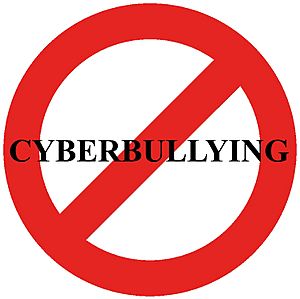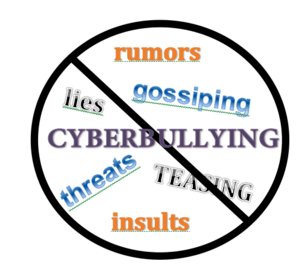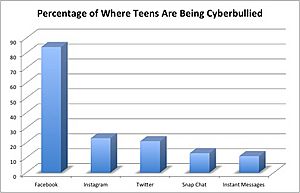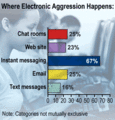Cyberbullying facts for kids
Cyberbullying is a type of bullying that happens using electronic devices. This includes phones, computers, and tablets. It can happen through text messages, social media, games, or other apps. Cyberbullying has become very common, especially among teenagers.
Harmful things bullies do online can include spreading rumors about someone. They might also send mean messages or threats. Sometimes, they share someone's private information, like their home address. They might also use hurtful words or hate speech.
Bullying is usually behavior that happens again and again. The person doing it means to cause harm. Victims of cyberbullying might feel sad or have low self-esteem. They can also feel scared, frustrated, angry, or depressed. Many people say that cyberbullying can feel even worse than traditional bullying. This is because it can happen anywhere, anytime.
In the United States, people became more aware of cyberbullying in the 2010s. This was partly because of some well-known cases. Many states in the US and other countries now have laws about cyberbullying.
Contents
What is Cyberbullying?

Cyberbullying is often described as an aggressive act. It is done on purpose by a person or a group. They use electronic ways to contact someone. This behavior happens many times over a period. It targets a victim who cannot easily defend themselves.
The National Crime Prevention Council has a simple definition. They say it is "using the Internet, cell phones or other devices to send or post text or images intended to hurt or embarrass another person."
Cyberbullying is like traditional bullying in many ways. But there are some big differences. Victims of cyberbullying might not know who their bully is. They also might not know why they are being targeted. The hurtful content can spread very quickly online. It can be shared with many people. Often, it stays online for a long time, even after the bullying stops.
The words cyberharassment and cyberbullying are often used to mean the same thing. But some people use cyberbullying mostly for harassment among kids or in a school setting.
Cyberstalking
Cyberstalking is a serious type of online harassment. The person doing it uses electronic messages to stalk a victim. Cyberstalking is often seen as more dangerous than other cyberbullying. This is because it can involve real threats to the victim's safety. Cyberstalkers might send many messages to threaten or bother their victim. They might also trick others into contacting the victim.
Trolling
Internet trolling is a common way people bully online. It happens in online communities, like in online gaming or social media. Internet trolls try to make others angry or upset on purpose. They do this to get a reaction, cause trouble, or just for fun. Not all trolls are cyberbullies. Some trolls just want to cause harmless mischief. Others might be genuinely difficult people.
Doxxing
Doxxing is when someone shares a victim's private information online. This can include their home address, phone number, or full name. Doxxing can happen when fans of a celebrity or group go too far. They might try to protect their idols and end up cyberbullying others. For example, some extreme fans of K-pop music groups have shared private info about fans of rival groups.
Hate Raids
On Twitch and other livestreaming sites, hate raids are a problem. This is when many viewers "raid" a stream. They flood the chat with hateful messages and harassment. This makes it hard for the streamer to continue their show. These viewers are often automated bots, which makes them hard to stop.
Spam
Spamming is when someone creates many fake accounts. Then, they send a huge number of messages to a target.
How Cyberbullying Happens
Guides for the public, teachers, and parents explain cyberbullying simply. They say, "Cyberbullying is being mean to others by sending or posting harmful material using a cell phone or the internet." Experts are always researching and learning more about this topic.
Here are some key things to know about cyberbullying:
- It involves repeated behavior.
- The person doing it means to cause harm.
- It can be harassment or cyberstalking.
- It can involve spreading cruel rumors or lies to hurt someone's reputation.
- It can be impersonation, where someone pretends to be another person.
- It can be exclusion, where someone is purposely left out of an online group.
Cyberbullying can be as simple as sending emails or texts to someone who has asked you to stop. It can also include public actions. For example, repeated threats or using hate speech. Bullies might gang up on a victim in online forums. They might make fun of the person. They could also hack into someone's accounts or post false things about them. This is done to make the person look bad or embarrass them.
Cyberbullying might involve posting rumors about someone online. The goal is to make others dislike them. It can even go as far as sharing private details about crime victims. Or publishing things that are very mean or embarrassing about them.
Cyberbullies might share a victim's private information. This could be their real name, home address, or school. They might post this on websites or forums. They could also use impersonation. This means they create fake accounts or comments. They pretend to be their target. Then they publish things in the target's name that are mean or make them look silly. This can make it hard to find the cyberbully. But not all cyberbullies stay anonymous. Even text messages or emails between friends can be cyberbullying if they are hurtful.

Today, many people use mobile apps and smartphones. This has made cyberbullying even easier to do. It is expected that cyberbullying through these devices will become more common. This is especially true compared to bullying on computers.
Smartphones have cameras and internet access. This makes certain types of cyberbullying possible. For example, sharing embarrassing photos or videos instantly. People who are cyberbullied on mobile devices might experience more types of bullying.
Getting Help
Most states have laws that include electronic communication in their harassment laws. Many police departments have special units for online crimes. Online stalking is often taken very seriously. You can search for help and resources in your area if you or someone you know needs it.
Related pages
Images for kids
-
Where cyberbullying happens for young people in the US, according to the Centers for Disease Control
See also
 In Spanish: Ciberacoso para niños
In Spanish: Ciberacoso para niños





